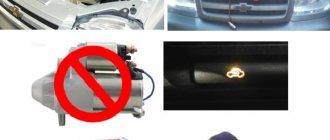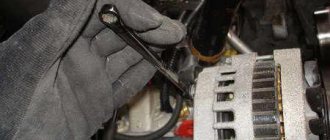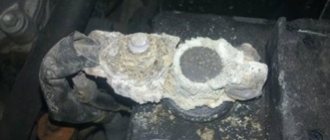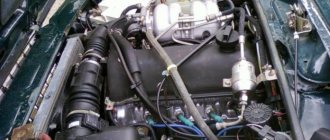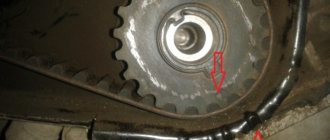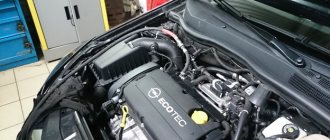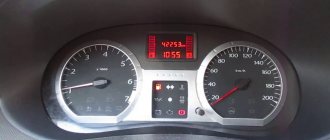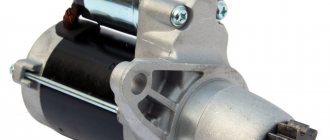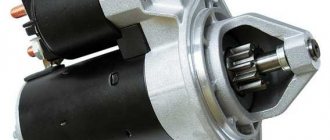January 28, 2016 Lada.Online 251 666 6
Often, owners of a VAZ 2121 or 2131 SUV encounter problems with starting the engine. For example, when you turn the ignition key, the starter does not turn. Let's look at possible problems with the Lada 4×4 starter and ways to solve them.
VAZ 2121 starter does not turn
For starter malfunctions , see the section Diagnosing engine malfunctions: “The crankshaft does not turn with the starter”, “Loud noise when the starter is running”
How to check the functionality of the starter circuit
If the starter does not crank the engine when the ignition key is turned to the appropriate position, then there are four possible reasons:
1. the battery is discharged;
2. the electrical connections between the starting relay, battery and starter are broken, i.e. current from the battery is not supplied to the starter;
3. the starting (traction) relay is faulty;
4. the starter is stuck or its electrical part is faulty.
• To check the battery, turn on the headlights. If they go out after a few seconds, the battery is discharged or damaged. If the headlights are bright, turn on the starter and see what happens to the headlights. If the headlights dim, voltage is supplied to the starter, but it does not rotate. The starter needs to be removed for inspection. If the starter rotates very slowly, proceed to the next test.
• If the headlights still shine brightly when you turn on the starter, then there is no voltage reaching it. Check all connections from the battery to the start relay and starter for tightness and cleanliness. If the car has a good battery, then the most likely cause is a malfunction of the starter itself. Check that the flexible ground wire between the engine and the body is tightly screwed - this sometimes helps eliminate an apparent malfunction.
• If no results are achieved, turn off the headlights to avoid draining the battery. You may hear a clicking sound each time you turn the ignition key to the starter position. These are the sounds of the solenoid (traction relay) operating, but this does not mean that the main contact is operating properly. (If you do not hear a click from the relay, it may be faulty.) The solenoid contact can be checked by connecting a voltmeter or test light to the main wire connection (battery to starter) on the "starter" side of the relay and to ground. When you turn the ignition key, the voltmeter should show voltage, or the light should light up. If this does not happen, then the traction relay is faulty. (Do not connect a light bulb to the two relay contacts. If the starter is working, the light will light up.) If, in the end, it is determined that the relay is working properly, and voltage from the battery is supplied to the starter, then most likely the starter itself is faulty.
Video
When the lock is turned on, the starter relay activates, clicks, but the starter does not work. The battery is new, the starter is good, the entire chain has been checked. What else could it be?
- Niva 2121 won’t start – 11 answers
- The starter, when starting, is disconnected from the flywheel - 3 answers
- The starter does not turn the flywheel of VAZ 2121 - 2 answers
- Removing the starter on a Niva - 1 answer
- Niva starter does not turn over - 1 answer
The contacts on the solenoid relay are probably burnt out.
There may be a problem with the retractor, contacts. In any case, remove it and at the same time clean all contacts and clean the starter from excess dirt and dust. When installing, tighten the wire fastenings well. Good luck.
Tapping the starter with a wooden hammer handle (gently) should help.
Subscribe
to our channel in
Index.Zen
Even more useful tips in a convenient format
The Niva 21213 and 21214 cars have a starter with mixed-type excitation, with an electromagnetic-type traction relay and two independent windings. Four poles are fixed in the housing, one of which is connected in parallel, and the rest in series. The casing and cover are tightened using a pair of bolts. Inside there is an armature with a collector (the latter is of the end type). The armature rotates on metal-ceramic bushings pressed into the covers.
Despite the apparent design complexity, starter repair is accessible even to beginners. The main thing is to have the necessary tools on hand, diagnose the problem in a timely manner and follow the manufacturer’s instructions. Below we will look at what starter malfunctions exist and how to fix the problems.
During operation, the following problems are possible: 1. After turning the key in the ignition switch, the Niva car does not start, the starter does not turn. Causes of the problem:
- The machine's power supply has run out. The terminals on the battery or the terminals of the connected wires are oxidized. The terminals are poorly stretched. Interturn short circuit or damage to the traction relay winding. The switching starter relay has failed or there is a break in the power supply wire of the device. Lack of closure between the “thirtieth” and “fiftieth” contacts.
In the cases described above, the faulty element is replaced or repaired, and the contacts are cleaned.
2. When the key is turned in the ignition switch, the relay works, but the starter does not turn (hot or cold). Causes:
- The battery is discharged or damaged. The fastening of the lugs of the wire connecting the engine with the body part has been loosened. The “plus” and (or) “minus” on the power source is oxidized, poor traction. The commutator was burnt and the brushes were worn out. The positive terminal of the brush holder was at ground. There is a break in the armature and (or) stator windings.
Depending on the malfunction, the faulty part is replaced or repaired, the contacts are cleaned, or the short circuit is repaired.
3. Upon supplying voltage to the starter, the relay is activated repeatedly and then switched off. The engine does not turn over (the problem occurs when it is hot or cold).
- Short circuit or break in the relay winding. Battery discharge. Reduced voltage at relay contacts (occurs when wires oxidize).
4. After voltage is applied, the starter armature rotates, but the engine flywheel does not. Causes:
- The clutch engagement lever has failed. Clutch slippage.
5. A strange sound appears when the armature is turned:
- The starter fasteners are loose or the device is mounted askew. The integrity of the flywheel gears or drive gear is damaged. Bearing bushings are worn out. The starter fastener is loose.
6. The gear hangs in fixation with the flywheel:
- The lever, traction relay or splined coupling is stuck. The ignition switch is broken (at the junction of the contacts). The springs of the traction relay are weakened or damaged.
Video repair:
Regardless of whether the engine turns or not, each of the above cases requires repair or replacement of damaged components .
Let's look at how to do this work below. Algorithm of action: Use the key set to “thirteen” to loosen the fastening of the conductor connected to the traction relay. Discard the tip.
To check the VAZ-2121 relay, apply a voltage of 12 volts to the relay output, and apply “-” to the body. Connect a resistance meter to the contacts. If the relay is intact, then the armature pushes out the overrunning clutch, and the contacts close. If a part is found to be faulty, replace it.
- To remove the traction relay, remove the three screws using a slotted screwdriver. Pull the rod with the spring out of the device casing, and install the new traction relay using the reverse algorithm.
If the problem persists, continue repairs:
- Take a Phillips screwdriver and tighten a couple of screws, then remove the casing. To check the integrity of the brushes, twist the fastening screw of the contact conductor, and then use a screwdriver to press out the spring. Next, it remains to remove the brush. In a similar way, remove the remaining three brushes and inspect them. If at least one of the brushes is up to 1.2 centimeters high, then it must be replaced (further use of the part is not recommended).
- Connect a multimeter to the starter windings (one at a time) and check them for a short circuit. The task is to make sure that there is no short circuit between the turns and on the housing. Using a screwdriver, lift the locking ring, remove the washer from the shaft and, using a ten-socket wrench, tighten a pair of tightening bolts. Separate the starter elements and remove the insulating tubes. Inspect the appearance of the windings and commutator. Remove burn marks from the collector using sandpaper. If this part is severely worn or charred, then repair is useless - the device is replaced. Remove burrs using fine-grained sandpaper, then polish the product. Use a multimeter to check the armature for a short circuit. If a problem is found, replace the unit. Remove the rubber seal from the drive cover and remove the washer to adjust the armature. Remove the cotter pin of the lever axle and select the last one. Next you need to remove the armature along with the drive.
- Pry up the drive lever of the screwdriver and remove it. Check the car's gear - it should turn easily left and right. Also inspect for nicks and chips. If the gear is worn out or the clutch is out of order, then it is useless to carry out repairs - replace the assembly. Support the shaft on a wooden block and knock out the limiting ring. Use a screwdriver to pry up the ring and remove it. Remove the restrictor ring and the overrunning clutch together with the gear. Assemble the starter using the reverse algorithm.
The car won’t start – we check the main possible problems
The most common occurrence of problems with the engine or electrical system of a car is a lack of ignition. There are different options for the implementation of this breakdown, so you need to know the difference in order to determine the specific unit to blame for the failure to start the engine. The starter may spin, click or be silent, the engine may start and immediately stall, and also make sounds that are unusual for it. It is worth dealing with these manifestations so as not to make the breakdown even more complicated.
Firstly, if the car does not start, you should stop trying to start the engine until the problem is clarified. The timing belt may have broken on the car, and your successive attempts to start the engines will lead to valve failure. Let's look at the main possible manifestations of problems that cause poor engine starting.
Problems with the starter and electrical system of the car
Often the answer to the question of why the car won’t start lies on the surface. Poor performance of the starter or its complete failure is the cause of 80 percent of problems with starting the power unit. Therefore, first of all, check this unit for its correct operation.
Also, starting the engine can be complicated by a dead battery or a broken wire in the car's electrical system. The wire leading from the battery to the starter often breaks, and the car does not respond at all to turning the key in the ignition. Manifestations of problems with the starter are as follows:
In the latter case, the culprit of the problem will be the bendix, which should move out of the starter and turn the engine. This element often wears out and does not perform its tasks. The first types of problems are related to the solenoid relay. Replacing it can often solve this problem.
If your car's battery is dead, the starter will only turn once or twice without starting the engine. Lazy sounds under the hood also mean a dead battery. In all these cases, you can easily start the car from a pusher or with the help of a tow, and in the event of a battery failure, you can light a cigarette from the battery of another car.
Problems when starting the engine related to the power unit system.
Often problems with starting the engine are based on problems with the unit itself, and in this case you need to be much more attentive to extraneous sounds and other possible manifestations of the problem. If the engine knocks during startup, a possible problem is hidden in the piston group or in the valves. The ignition setting may also be lost.
Here everything depends not only on the operating characteristics of the car, but also on the type of engine itself. In some units you can try to find the problem yourself; in the case of modern foreign equipment, you will have to evacuate the car to a service station. The main problems that occur in the engine system and prevent the car from starting are the following:
Also, the car may well not start due to low octane gasoline or poor fuel quality. Diesel engines can be difficult to operate in winter due to possible fuel freezing. The more technology and automatic solutions are present in a car, the more possible problems can be found.
If you understand that the problem of the power unit not starting is not related to the battery or starter, stop trying to start the engine, because you can only make things worse. It is better to invite a specialist or tow the car to a professional station to detect and fix problems.
See what a broken timing belt can lead to on some cars:
Let's sum it up
If your car refuses to start, you shouldn’t torture it with every second attempts to turn the key in the ignition system in an effort not to be late for work. Use the services of a specialist to identify possible problems and get more information about the problem. Then you can easily detect the breakdown and fix it.
If the engine does not start for more serious reasons, the service station will tell you possible ways to fix the problem. It is enough to find specialists who are well versed in your make and model of car. Are there any situations in your driving experience when it was very difficult to determine the reasons for the failure of the power unit to start?
What is the reason? (unexpectedly the starter failed)
I was driving myself. went to a roadside store. I sit down and the starter doesn’t turn. at all. went. I looked at the contacts. kicked the wheel. doesn't spin. Pushed started. I drove 100 m. For the sake of experiment, I tried to crank the starter. works. as if nothing had happened. There were no problems before this. the starter is new. The ignition switch is new. The battery is in very good condition.
where to dig? Otherwise, I don’t smile at the parking lot to carry the car in my hands in case of a sign of failure.
Check the starter relay There is a relay block under the steering column on the left under the upholstery. find the starter relay (No. 30) orange-orange-blue-black-double-margin and try to replace it with another one, for example, heated rear window (No. 25) orange-black-gray-green-orange-black if it works, that’s it.
The relay could burn out - sometimes there is contact and sometimes there is no contact, throw away the old one, buy a new one
If the starter was old, then it’s quite possible that one branch of the rotor burns out and if it stands up in such a way that the brush hits this “dead” plate of the rotor commutator, then the starter just clicks. But if you click many times (about 5-10) or start the car in any way, then the vibrations, as a rule, start it with a bang. In addition, there can be a lot of these “dead” spots (I used to have 3 of them on the 412)
But this is most likely not your case because... your starter is new.
This is how we started the ZIL in the army: one turns on the starter, and the other pulls it “crookedly”.
Then the starter turns on its own.
Re: This is how we started the ZIL in the army: one turns on the starter, and the other pulls it “crookedly”. > > Then the launcher turns on its own. > > :o)
+++ And the crooked one knocks out teeth and tears off hands :-))
Source
Selection of components
The original starter is produced by LADA and comes in the original blue packaging. It is marked with article number 21214-3708010-01. The cost of this part is from four to five thousand rubles, depending on the store.
To avoid stumbling upon a fake, carefully examine the box. The presence of extraneous logos, absence of an article number on the box, or color mismatch is unacceptable. The low price should alert you.
Alternative options are produced by companies such as Fenox, Krauf, Valeo. The listed brands are distinguished by high quality products and fairly affordable prices. The price for starters varies from 2200 to 4700 rubles.
What original or analogue can I supply?
If the starter does not turn, you can simply replace it. Typically, in a store, the buyer has a choice between two options:
- original;
- analogue
They differ not only in their quality, but also in their durability. The easiest way to study visual differences is in the photo.
But the cost of the original starter is usually at least 3.5 thousand rubles. That’s why many people opt for analogues. There are many other manufacturers on the Russian market that are not certified by AvtoVAZ. If possible, you should choose well-established brands.
It is important to remember: all starters have different resources and may differ in size. It is advisable to arm yourself with a ruler and tape measure before going to the store.
This will allow you to avoid purchasing a device that is not suitable in size. Some manufacturers produce equipment that can be installed on various vehicle models. The price depends significantly on the manufacturer.
Before purchasing an analogue, you need to familiarize yourself with the brand. For example, Bosch has proven itself to be good. The equipment he produces is durable and does not cause difficulties in repair. There is a list of manufacturing companies recommended by AvtoVAZ itself. It is advisable to familiarize yourself with all the nuances and subtleties of installation in advance. This will allow you to select it at the start and install it later yourself.
This is interesting: High input voltage of the IAT sensor - error P0113 VAZ
Removing and installing the starter
The starter on a Niva rarely has to be changed, but if you have a need for this, the instructions below will be very useful. First, it’s worth considering the necessary list of tools with which doing all this will be very simple and will not take much time.
Detailed guide to replacing the starter on Niva VAZ 2121
- First of all, open the hood of the car and disconnect all the power wires from the starter structure. To do this, you will need to unscrew the nuts that secure the terminals with a 10mm head. It is impossible to get there with a regular wrench, so a ratchet with a head and an extension would be an ideal option. We feel for the terminal nuts with our hands and, using the ratchet handle, unscrew them one by one.
- To show everything clearly, look at the photo below; the key is inserted just under the Niva’s exhaust manifold:
- And after that, you can freely disconnect the power wires, which are not attached to anything else:
- Next, take a 13mm wrench, it’s more convenient to use a spanner, and unscrew the 2 bolts securing the starter housing to the engine. But there may be three of them; personally, in my example there were only 2.
- And then you can shoot it to the right, as clearly shown in the photo below:
- And turning it a little to the side, we take it out without any problems:
As you have seen for yourself, there is nothing complicated in this repair, the main thing is that you have all the necessary tools at hand and then any work on your Niva will be done quickly and without unnecessary nerves.
We install the VAZ 2121 starter in the reverse order of removal. If necessary, we replace it with a new part.
conclusions
Having determined exactly whether there is a particular problem that is preventing the engine from starting, you can know for sure whether you can do this work yourself, or whether you will have to use the services of a car repair shop.
In most cases, you can do it yourself, since the replacement work is not complicated. An important aspect will be the fact where the work will be done, on the street or in the garage, since in the case of the latter, no natural phenomena will force you to finish the work for reasons beyond your control.
Possible malfunctions if the starter does not turn
| Possible malfunction | Diagnostics | Solution |
| Battery is discharged | The starter clicks but does not turn. The voltage at the battery terminals with consumers turned on is less than 12 V | Charge or replace the battery |
| Oxidation of battery terminals or poor connection | The starter clicks but does not turn. When the starter is turned on, the voltage at its terminals drops much more than at the battery terminals | Clean the contacts, lubricate with Vaseline and tighten well |
| There are problems in the wiring of the starter traction (retractor) relay, ignition contacts 30 and 50 do not close. | When turning the key there is no click under the hood (the relay does not work). Check the presence of voltage at the control contact of the solenoid relay | Clean the contacts, lubricate with Vaseline and tighten well. Replace the ignition switch |
| The starter solenoid relay is faulty. | When you turn the key, there is no click under the hood (the relay does not work), but there is +12 V at the control contact of the solenoid relay. The starter spins when closed with a screwdriver. The starter does not turn only when it is hot (when the engine is warm) | Replace starter relay |
| Solenoid relay contacts are oxidized, poor ground contact | When you turn the key there is a click under the hood, but the starter does not turn. Using an ohmmeter, check the resistance of the “battery - starter” circuit, as well as the ground wire. If the circuits are OK, remove the starter and check the operation of its relay | Clean the contacts, lubricate with Vaseline and tighten well. Replace the solenoid relay |
| Open or short circuit in the holding coil of the solenoid relay | When the starter is turned on, a cracking noise is heard from under the hood. The battery voltage is within normal limits. The relay is checked with an ohmmeter or by its excessive heating | Replace starter relay |
| Burnt starter commutator, stuck brushes or severe wear | The starter does not turn or turns slowly. With the starter removed, check the pressing force of the brushes to the commutator, their residual height, and wear of the commutator | Repair the starter. If the commutator is very worn, replace the starter. |
| Open or short circuit in the starter armature winding | The starter does not turn or turns slowly. The serviceability of the winding is checked with an ohmmeter or by darkening of the insulation | Replace starter |
| Freewheel slipping | The starter spins, but the flywheel is stationary | Replace clutch or starter |
| The ring gear rotates on the flywheel | The starter spins, but the flywheel and crankshaft are stationary. There is a squeal, a howl from the clutch housing | Replace flywheel |
| The engine or attachments are jammed | Check the rotation of the crankshaft, alternator pulleys, coolant pump and power steering pump | Repair the engine or its attachments |
| The starter drive gear or flywheel ring teeth are damaged | Visual inspection after removing the starter | Repair or replace starter, replace flywheel |
Have you encountered the problem of starting the engine when the starter does not turn? What was the cause of your problem? Let us remind you that other instructions for repair and operation of Lada 4×4 can be found in this category or by content.
Keywords: 4x4 starter | 4x4 engine | 4x4 ignition system | 4x4 power system | ECM 4x4
Share on social networks:
Found an error? Select it and press Ctrl+Enter..
Messages 10
1 Topic by Djin 2014-05-03 22:13:33 (2014-05-03 22:15:12 edited by Djin)
- Djin
- New member
- Inactive
- Registration: 2014-03-20
- Messages: 14Thanks: 9
- Car: VAZ 21102
Topic: Resolved: Starter does not turn over when engine is warm (after driving)
Good day! The essence of the problem is that when the car is cold it starts, the starter always fires, but when you drive it (i.e. it warms up), turn it off, and start to start the starter does not work. Sometimes it starts 2 times, sometimes it takes 2 minutes to turn the key back and forth and then it locks. If the starter does not operate, the indicators on the instrument panel dim. This was done to solve the problem (it didn’t help): all the terminals on the battery are screwed on and cleaned well; The (+) wiring to the starter is also cleaned and tightly put on. I ask for help and advice. The retractors die.
2 Reply from igorek 2014-05-03 22:41:18
- igorek
- Brother-in-law
- Inactive
- From: Bryansk region g Starodub
- Registration: 2013-05-05
- Messages: 416Thanks: 191
- Car: VAZ-21102 1.5i-8V Bosch MP7.0H
Djin, look at the starter relay, perhaps the contact group in the ignition switch is also what the brain does. also the wiring of the connection point of the chips, the voltage drawdown from the poor contact somewhere, good luck in the search
3 Reply from Sergey VAZ 2111 2014-05-04 15:20:14
- Sergey VAZ 2111
- Connoisseur
- Inactive
- Registration: 2013-11-21
- Messages: 513Thanks: 145
- Car: VAZ 2111
check the wires when the engine is hot.
4 Reply from klimashov.roman 2014-05-05 09:26:41
- klimashov.roman
- Connoisseur
- Inactive
- From: Kasimov
- Registration: 2014-04-21
- Messages: 743Thanks: 143
- Car: GAZelle 33023 dv 405.22, 2.4 16kl 140hp
The contact group is unlikely since the problem is described during heating. The relay might be worth a look. Most likely the retractor or the entire starter itself. I had the same problem, no matter how I treated it, replacing the retractor only gave a temporary effect. Disassembling the starter is the only way you will find out the reason. I struggled with money for a long time, threw away half the cost of the starter and ended up having to buy a new one. If you want, disassemble the retractor itself and look at the spots, if they are burnt, clean them, put everything back and lubricate the starter itself with oil, just don’t pour too much without fanaticism. It should work out
5 Reply from Zloy 2014-05-06 22:01:29 (2014-05-06 22:10:18 edited by Zloy)
- Wicked
- New member
- Inactive
- Registration: 2014-01-20
- Messages: 7 Thanks: 2
- Car: VAZ-21102
And who’s stopping you (when it won’t start) to apply + directly from the battery to the starter control contact (after disconnecting the chip from the ignition switch or the starter relay - depending on the year of manufacture of the car). Do this with the ignition on and the gear off. If the car starts, then the starter is normal, look for a problem in the ignition switch or wiring, or in the starter relay if there is one (most cars did not have one).
6 Reply from Serg 2014-05-11 09:18:57
- Serg
- Lada2111.rf fan
- Inactive
- Registration: 2013-07-29
- Messages: 830Thanks: 363
- Car: 2111 dwg 2114 year 2008
The problem is trivial and as old as the world - a hidden defect of the manufacturer - modern starters do not have a starter winding; instead, powerful magnets are installed with a small gap between the armature and the stator; when cold, during further operation this gap is masked and therefore, when the starter is cold, the armature can rotate even to some minimum level. then with warming up the gap is selected by temperature expansion and the armature jams tightly - there are two options: the first is to disassemble and wash the stator (at the same time do maintenance), if the magnet(s) are unstuck then option two. new
- Jigull
- New member
- Inactive
- Registration: 2014-05-11
- Messages: 2Thanks: 0
- Car: VAZ 21124
Modification: heat protection casing
As a rule, the starting device on the Niva and other domestic cars begins to deteriorate like this. At first it is difficult to start the engine, then a whistle appears. When parked for a long time, the car does not start at all, and the battery quickly runs out. If the device is not diagnosed in such a situation, the problem will get worse. There are usually two reasons why the starter is not checked immediately:
- battery - if replaced, the battery will withstand a faulty starter for some time, and the engine will start properly;
- wires and terminals are cleaned of rust, which improves the current supply and plant, but also for a short time.
No fuel supply
Often the engine does not start if the fuel supply system is faulty or incorrectly adjusted. Attempts to start such an engine are usually accompanied by popping noises, shots in the muffler, the appearance of black smoky smoke and a strong smell of gasoline from the exhaust pipe. A malfunction in a carburetor engine is usually determined visually.
It is enough to shine a flashlight into the primary and secondary chambers. If there are traces of gasoline on the walls, and fuel does not spray out of the accelerator pump nozzle, but flows out in a thin stream, it is necessary to urgently identify and eliminate the malfunction. To accurately determine a malfunction in an injection engine, you need special equipment that is connected to the vehicle’s diagnostic connector and is capable of reading error codes and faults.
To determine the serviceability of the injectors, you should disconnect them from the ramp, and then ask an assistant to crank the engine with the starter. If gasoline flows out of the injector nozzle in a thick stream or does not flow out at all, the injector should be washed in an ultrasonic bath or replaced.
To avoid various surprises along the way, it is recommended that you always check all engine systems before leaving, eliminating minor faults. For example, loose contact, friction of wires and hoses on various protrusions, leaks of oil and other liquids, etc.
In this case, you can not only eliminate minor breakdowns, but also identify and prevent more serious ones, which can lead to significant expenditure of effort and money. Always stay mobile. Good luck on the roads!
What kind of starter can be installed
- Motorherz STB0373RB. This company is a large supplier of auto parts that has its own production. It sells hydraulic power steering pumps, turbochargers, starters, generators, steering racks, repair kits, etc. The cost of a starter unit for a VAZ 2131 is 3,940 rubles.
- ATE is a plant located in the Moscow region, engaged in the creation of electrical equipment for domestic cars. The ATE-1 starter unit is an inexpensive product that fully justifies its cost. The price of a starter for a VAZ 2131 car is 3250 rubles.
- The production of a starter for this vehicle is also carried out by the Stary Oskol Automotive Equipment Plant. The history of the enterprise goes back more than 55 years. The cost of a starter unit for a VAZ 2131 is 3,400 rubles.
In some cases, the car will not start because there is a malfunction in the power plant. The main reasons may be: thick oil that does not match the season, as well as jamming of the power unit shafts. In most cases, the starter relay fails.
The solenoid relay is replaced if:
- There is a break in the relay winding. It is worth considering that the solenoid relay is equipped with two windings: a starting winding (from the control contact to the output power terminal) and a holding winding (from the control contact to the relay body). It is also possible that an interturn short circuit may occur in the windings. The main symptom of this malfunction is the appearance of a strong smell of burnt insulation. The windings are checked on the table by applying voltage from the battery: the “negative” contact is connected to the housing and the output power terminal, and the “positive” contact to the control contact.
- If the voltage drop across the solenoid relay is more than 0.3-0.5 volts. This phenomenon indicates that the power contacts have burnt out.
- If an external inspection indicates the presence of burnt areas on the plastic cover, near the power contacts.
Voltage blocking alarm
Modern security systems fully control the car, its elements and assemblies. In emergency situations, the alarm will prevent theft, but the alarm may be false.
The reasons for the “false call” are caused by:
- manufacturing defects,
- short circuit in the circuit,
- malfunctions in the operation of the electronic control unit,
- damage to electrical wiring, insulation,
- poor terminal contact.
In order to be able to start the car in the future, you need to deactivate the alarm. However, you need to know what to turn off. To carry out work at a professional level, visit a service station.
How to remove the starter thermal cover on a Chevrolet Niva
Based on the experience of Chevrolet Niva owners, it turns out that there are two ways to dismantle the ill-fated casing - pick it out with a pry bar and dispose of it, but then the starter will be left without protection, or spend several hours dismantling it.
The starter is more expensive, so we proceed to dismantling using this technology:
- It is imperative to de-energize the car by disconnecting the negative terminal of the battery or turning off the mains switch.
- Remove the engine protection. To do this, you need to install the car on a viewing hole or a lift.
Now that we have the casing in our hands, we assess the degree of damage - if the eyes are simply broken off, we can either weld them well to the casing or put them on bolts, this is more reliable.
Some recommend laying a layer of asbestos between the starter and the shield, but if there is a gap in this place, you can count on some kind of cooling. Before putting the starter protection in place, you need to make sure that you have new exhaust pipe gaskets (on the manifold side and on the muffler side) and new bolts and nuts on hand. Only now you can put everything back together in reverse order.
Option without air conditioning
In some cases (if the car does not have air conditioning), you can do without dismantling the exhaust pipe. To do this, you need to unscrew the engine mount and jack it up, resting one end of a wooden block on the exhaust manifold closer to the cylinder block, and the other on the jack.
So you can try to bring the heat shield back, besides this there is another way - dismantling the exhaust manifold. Without a collector, the shield can be easily removed.
Good luck to everyone and enjoy your travels!
Problems with the relay or battery
If, when you try to start a Priora car or a car of another brand, you hear a click, but the starter turns very slowly, you need to clean the nickels. In some situations it may be necessary to solder a new contact layer. If you suspect that the cause is in the motor, you need to close the contacts in the relay. If after this the engine was able to start the first time, look for the cause of the malfunction in the relay. Otherwise, the cause lies in the engine itself.
Often this problem occurs due to a fault in the relay. This is evidenced by the occurrence of several clicks that occur one after another when trying to start the car. If you listen, it becomes clear that this sound is made by a relay. It occurs due to the fact that the starter receives an electrical charge, but the current only reaches the traction relay and does not reach the engine spin-up mechanism. In this case, you can immediately rule out the version of a discharged battery, since due to the low charge, the starter would still be able to turn, but slowly and only a few times.
How to remove the heat shield without removing the starter?
How to remove the heat shield without removing the starter?
Post by Niva867 » 08 Jun 2012, 16:52
There is a problem. You need to get to the wires to the starter, remove them, and clean the contacts in order for it to start. I don't need to remove the starter at all, I just need to remove the heat shield. The heat shield is secured with 3 bolts, 2 at the top, 1 at the bottom. I unscrewed them. But the heat shield cannot be pulled out. I tried it in front, and back, and up and down. Then he turned it around and went to drink beer.
Post by Anton » Jun 08, 2012, 04:57 pm
Re: How to remove the heat shield without removing the starter?
Post by Niva867 » 08 Jun 2012, 20:18
If you move the shield forward, it will rest against the hose. (the size of the hose is the same as from the expansion tank to the radiator) Does this hose need to be removed?
Re: How to remove the heat shield without removing the starter?
Post by Captain » 09 Jun 2012, 02:32
Re: How to remove the heat shield without removing the starter?
Post by Niva867 » June 14, 2012, 07:07 pm
Why didn’t anyone tell me that the battery needs to be turned off? There was a firestorm there today.
In short, I removed the starter, the bottom bolt was the easiest, the middle one the most difficult. He unplugged it and pulled it out. Then, using pliers, I bent and broke the screen, took it out and threw it away.
Now if something happens to the starter, it will be easy to loosen the wires!
Ignition
If the previous steps did not help, proceed to checking the ignition. The most common problem occurs due to moisture accumulation in the distribution cap. Do the following:
- Remove the cover and inspect for condensation.
- If there is one, wipe with a dry cloth. Before wiping, check the lid for cracks - if there are any, just throw it away and buy a new one.
If everything is fine with the cover, check the wires for electrical conductivity. Bring the tester to the insulation and wait for a successful outcome. It will be so if you do not detect current: with normal wires, the insulation will not allow it to pass through.
Starter on Niva Chevrolet
VAZ 2107 starter: device, fault diagnosis, repair and replacement
It happens that the car starts intermittently or does not start at all. One of the common reasons for this may be a faulty starter on a Chevrolet Niva. To accurately understand whether there is a problem or not, you need to dismantle it and carry out diagnostics.
This part is a direct current electric motor and is activated by a permanent magnet combined with a planetary gearbox and relay. Before dismantling, it is advisable to understand whether this is the reason why the power unit does not want to start. This can be understood both by its appearance by conducting diagnostics and by replacing the battery with a new one.
Diagnostics
- All connections between the battery and the starter should be checked, as if there is poor contact there may not be enough power to crank the crankshaft. This problem can be solved by cleaning the contacts.
- It is necessary to check the battery, and if it is faulty, replace it
Replacement
If you are wondering how to remove the starter on a Chevrolet Niva, then you will find the answer to this question below:
- First of all, to prevent a short circuit, disconnect the battery
- The crankcase has a protection that needs to be removed
- Unscrew several bolts that secure the starter.
- Removing thermal protection
- Pull the part to be replaced towards you and disconnect the wires from it
- We clean the power wires since they could be the cause of unstable operation
When the part has been removed, you can diagnose it and try to repair it.
If you decide to try to make repairs, first of all pay attention to the planetary mechanism; you can understand the condition of the parts of this unit by disassembling it; just unscrew a few bolts. Most craftsmen claim that this mechanism cannot be repaired and in case of breakdown it is better to immediately replace it with a new one.
Most craftsmen claim that this mechanism cannot be repaired and in case of breakdown it is better to immediately replace it with a new one.
Retractor
To ensure that the starter does not experience additional loads, a special Niva Chevrolet starter relay is installed, it is also called a solenoid relay, consisting of:
When power begins to flow, the armature, under the influence of an electromagnetic field, begins to compress the spring, which leads to the rotation of the bendix. When the engine starts, the power is turned off and the spring relaxes.
Bushings
Bushings (aka bearings) are located in front and behind the starter. They are responsible for rotating the device shaft. If these elements are worn out, the starter will start clicking, but will not turn. Problems with bushings can also be caused by the fact that the starter is installed incorrectly, that is, it does not occupy the desired position along the axis. Or the winding could short-circuit. In this case, see the previous paragraph.
Healthy! Also, problems with the bushings will be indicated by “heavy” cranking of the starter, even if the engine is well warmed up.
Although many do not consider bearing failure to be a serious failure, they need to be replaced. Otherwise, the starter shaft will jam, which in turn can cause a fire.
Read news about the new Niva
- Chevrolet Niva starter relay where is it located
- Purpose of fuses, relays and their replacement Niva VAZ 21213, 21214, 2131 lada 4×4
- Diagram and location of the fuse box Niva VAZ-21213 and 21214
- Diagram and location of the fuse box Niva VAZ-21213 and 21214
- About engines for VAZ 2121 Niva
- Where is the starter relay located in the field?
- Fuses and relays (location and purpose of fuses and relays) Niva Chevrolet
- Chevrolet Niva fan does not turn on
Main block with fuses and relays
This block is located to the left of the steering column and is closed from below with a lid. To get to it, you need to tighten 2 screws, then press the top edge of the cover and gradually free it from all fasteners. The block that appears will be held on a special bracket. The fuse diagram itself and the number of elements on it may vary depending on the configuration and year of manufacture.
photo of the fuse box in a Chevrolet Niva
Scheme - option 1
Scheme - option 2
- Explanation of fuses
- F1 (5 A) - license plate lamps, instrument panel lamps, indicator light on the dashboard, engine compartment lamp, additional brake light lamp, left side marker lamps.
- If any of the listed lamps do not work, check this fuse and the lamps themselves, their connectors and wiring.
F2 (7.5 A) - low beam in the left headlight. Similar to relay K4.
F3 (10 A) - high beam in the left headlight, indicator lamp for turning on the high beam headlights on the dashboard. Similar to relay K5.
F4 (10 A) - backup fuse.
F5 (30 A) - front door electric windows and their relays. If, when operating the power window, the window goes down but not up (or vice versa), check the button on the door.
When lowering and raising, the polarity and direction of rotation of the motor are different. It could also be a problem with the window lift mechanism. To get to it, you need to remove the door trim. Check that the mechanism does not bite anywhere and that the gears are intact, without broken teeth.
If there are problems, you can replace the entire power window drive with a new one.
F6 (15 A) - door lock control unit. If one or more doors stop opening, check this fuse. The issue may be in the central locking, control unit, as well as the mechanisms themselves, rods and door locks. If you have no experience, it is better to contact a car service.
F7 (20 A) - sound signal and its relay, cigarette lighter. If the horn does not work, check this fuse, the steering column contacts and the wiring; the contacts may have oxidized and the wiring may have become frayed.
Broken bendix teeth or flywheel ring
This problem usually appears on cars with high mileage, especially after a recent flywheel replacement or repair of the starting mechanism. When you turn the key, the starter makes strenuous attempts to start the engine: it clicks, buzzes (sometimes with a squeal), but the internal combustion engine does not start. The problem here is the engagement.
Broken bendix teeth
The flywheel teeth (on most cars) are beveled to help the Bendix gear engage more smoothly. If there is significant wear, jamming of the traction relay fork, wedging or wear of the gear itself, it does not reach the point of reliable contact and does not fit along the relief of the teeth. Slipping leads to more wear and, since the part is not repaired, to unscheduled replacement.
If, when starting the internal combustion engine of a car, any extraneous sounds arise from the starter, this is a reason to check it as soon as possible. Otherwise, he will “remind himself” on the road.
general information
The starter is the key mechanism that ensures the starting of any vehicle equipped with an internal combustion engine. In fact, it is an electric motor equipped with a special gear with a transmission mechanism. When activated, the part engages with the flywheel and rotates it, thereby providing a start to the gasoline engine.
The control element is a solenoid relay. It supplies voltage to the unit’s motor and regulates the stroke of the bendix. When the driver turns the key in the ignition, an electrical circuit is activated. Current flows to the relay magnet, which attracts the armature, which closes the contact group, which causes the starter to spin.
The force it creates is transferred to the flywheel, the crankshaft begins to rotate and the car engine starts. After this, the driver releases the key, the power is turned off, and the relay opens the contacts, after which the starter stops working.
Silence when trying to start the engine
The Niva crankshaft cannot be turned by the starter.
There may be several reasons:
- Blown fuse.
- Poor contact between battery terminals.
- The battery is completely discharged.
- Failure of the starter solenoid relay.
- Failure of the intermediate relay that switches the starter circuit.
First of all, you should pay attention to the dashboard. When you turn on the ignition or the main electrical circuit in the engine, the lamps should light up on the dashboard or information should appear on the on-board computer, if we are talking about the Chevrolet Niva.
If this does not happen, the cause should be sought in the fuse box and in the battery contacts. During operation, oxides may form on these contacts, increasing the resistance. Loose contact connections can lead to sparking and burning.
If no blown fuses are found, you should check the reliability of the “+” contacts of the battery with the central wire and the “-” contacts with the vehicle ground.
To eliminate the malfunction, be sure to replace the fuses and clean the contacts. It would be a good idea to acquire even the cheapest tester in order to quickly check the presence of voltage in the electrical circuits of the car.
Fuel rail
On the ramp next to regulator 5 there is a control fitting 3
It is closed with a cap, which is unscrewed, and then carefully pressed on the spool
Ramp drawing
If fuel flows, it means it is entering the ramp. But perhaps the necessary pressure is not created. Reasons: clogged filter cylinder, pump malfunction, etc.
If fuel does not flow, notice whether the pump turns on when the key is turned to the “I” mark. When the ignition is turned on “cold”, the pump should run for 10 seconds.
Additional mounting block
Know that fuse F2 and relay P4 are responsible for turning on the pump. There is also a main relay P5, and all these elements are located in a block mounted on the same bracket with the ECM (see photo).
Case from practice
What happens if water gets into gasoline? In the summer - nothing. And in winter, the power supply system can become clogged with ice. All elements are at risk, from the pump to the injector valves!
Fuel supply line filter
A small amount of water is always present in fuel. If this number is increased, this is what happens:
- The first start always goes without problems;
- Then, after leaving the car in the parking lot, after 2-3 hours the owner will no longer be able to start the engine without repairs.
All of the above applies to any injection internal combustion engine, including the VAZ-2123. And the “first candidate for failure” will be the fuel filter. It is located under the bottom of the Chevrolet Niva and is encased in aluminum (see photo). However, this is done on many cars.
Pumping up excess air
One smart book says that the engine may not start due to the fact that the intake manifold draws in too much air. This means you need to check the fastening of all pipes. But not only.
Vacuum brake booster
The source of “excess air” may be a faulty VUT. The starter turns, the engine on the Chevrolet Niva does not start, and the reason, it turns out, must be sought in the brake system!
We won't look for anything. Let's do it simpler:
- The vacuum supply hose is removed from the amplifier side (see drawing);
- The hole in the hose is closed with a finger and one test run is performed;
- The engine starts, which means the cause has been found.
That's the whole trick. We wish you success!

